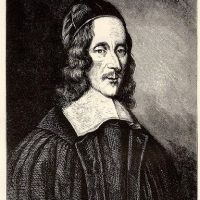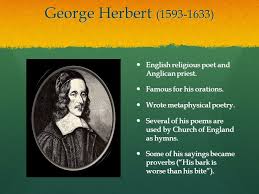
In this post we turn to the fine hymn-writing tradition of Wales, with a look at ‘King of glory, King of peace’ by George Herbert, to the tune GWALCHMAI by Joseph David Jones. Both writer and composer were born in Wales, though in very different circumstances.
We’re looking at George Herbert (1593-1633) for the first time, but as he is regarded as perhaps the father of English devotional writing, we will no doubt return to his work in future posts. Herbert was born into a noble family in Wales, then attended Westminster School and Trinity College, Cambridge. While Public Orator of the University he attracted the attention of James I, and was destined for a political career at court. However, the king’s death in 1625 deprived Herbert of his major patron, and he instead pursued a life in the clergy. Herbert wrote most of his poetry while Rector of Bemerton, near Salisbury. However he suffered from prolonged poor health, and died of consumption only three years after his appointment. His verses were then edited by his friend Nicholas Ferrar, who had them published in a 1633 collection, The Tempest. Since then, they have been lauded as prime examples of seventeenth-century metaphysical poetry. But they took on a second, parallel life in 1902, when some were included in a hymn book produced privately for Wellington College. From here, they were picked up by Percy Dearmer and Ralph Vaughan Williams, editors of the English Hymnal, who included several in that book’s 1906 first edition. Herbert’s place as not only a metaphysical but a devotional writer has, since then, been assured.
Joseph David Jones (1827-70), the son of a Wesleyan preacher, was born into such poverty that – it is said – his parents could only afford one year’s schooling for him. So to the detriment of all other subjects, he immersed himself in music. He began to write hymn tunes in his teens, and had several published to some success. Finding nearby music education lacking, he decided to offer it himself, and in 1851 was appointed headmaster of the British School in Towyn, Denbighshire. While gaining a degree of success at various eisteddfodau with his compositions, today he is best remembered for his hymn tunes CAPEL Y-DDÔL (at least in Wales), and GWALCHMAI. The origin of latter tune’s name is obscure – it may refer to a town in Anglesey, which itself is the Welsh form of the name known from Arthurian legend as Gawain (today rendered as Gavin). It was first published in 1868, two years before Jones’s death – where at the time, he was headmaster of a school he had founded in Ruthin, Denbighshire.
Bujor Florin Lucian shows us on the reed organ:
https://www.youtube.com/watch?v=hwiG5txc7pM
This post’s downloadable descant is built on the existing harmony, to reinforce its antiphonal nature, and help those who like to sing it in a ‘call-and-response’ style. As ever, it’s free to download and use, so please do so, and let us know how you get on. And we’d be delighted to receive any audio or video of your attempts.
If you’re using George Herbert’s hymn in a lesson, try considering the following points:
- The life and career of the author.
- The hymn’s structure as an antiphon: how in each verse, the first half contrasts with the second half.
- The ideas of devotion (verse 1), redemption (verse 2) and service (verse 3).
- The uncommon yet regular metre of the text (74.74.D), how this reinforces the structure, and the suitability of the music in reflecting this.
- A comparison to other hymns with similar themes, such as ‘Let all the world in every corner sing’ (George Herbert), ‘All people that on earth do dwell’ (William Kethe), or ‘Let us, with a gladsome mind’ (John Milton).
Is this hymn one of your favourites? Touching in its simple devotion, or not nearly deep enough for your taste? As ever, do let us know your thoughts in the comments section below.

